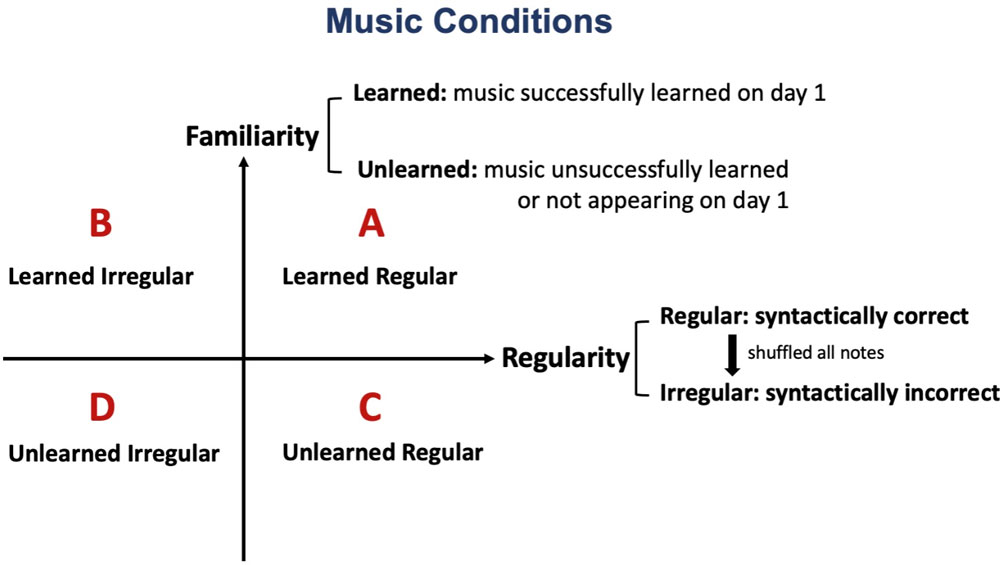When you are working on a math assignment or writing a paper, what are the sounds around you? Are family members or friends talking loudly? Are you listening to music? Or perhaps you prefer total silence? Just like our musical tastes, the type of background noise we prefer while studying is highly individualized. What works for me might not work for you, and vice versa. Still, there are patterns to the kind of sounds, and particularly the kinds of music, that are most conducive to learning. New research by Dr. Yiren Ren, former graduate student in the laboratory of Dr. Thackery Brown at the Georgia Institute of Technology (Georgia Tech) in Atlanta, GA, provides new insight into the qualities that make music supportive—or disruptive—to learning.
Music and Memory
Yiren is a multitalented musician who started learning piano at age five followed by guitar, drums, and traditional Chinese instruments. She planned to become a professional musician and started her college career majoring in sound design and film production. In college, she realized she was equally fascinated by human behavior and how the brain works, so she decided to double major in psychology.
After graduating from college, Yiren pursued a PhD in neuroscience that combined her interests in music and the brain. As a graduate student at Georgia Tech in the laboratory of Dr. Thackery Brown, himself a multitalented musician, Yiren designed a study to test the effects of music on memory. “People often ask me if they should listen to music or not while studying,” explained Yiren, “but the more interesting question is what kind of music might be conducive to learning.”
Studying and learning are general terms that encompass a wide range of different tasks. For example, doing math problems and writing an essay do not use your brain in the same way. Even in tasks involving memory, remembering how to get from home to school and back is distinct from memorizing vocabulary in a different language or important historical dates. For her research, Yiren decided to hone in on sequential memory, which refers to how series of events in our daily lives are encoded in our brains. Even though we experience life in a continuous way without any gaps, specific events get encoded into discrete chunks that we can retrieve later. The order of events in sequential memory is important.
Yiren chose to focus on sequential memory because it is important to our daily lives and because music is also sequential. She wanted to know whether our knowledge of a particular musical sequence could support different kinds of sequential learning. To find out, she designed a study where participants learned the sequence of a series of abstract shapes under different musical conditions.
In this study, Yiren was interested in two qualities of music: familiarity and regularity. Familiar music is music that you’ve listened to before, and unfamiliar music is music that you are listening to for the first time. To control for the kinds of music that individuals might find familiar or unfamiliar, Yiren used her musical talent to develop 12 original melodies (called musical stimuli) based on classical music. Each piece lasted eight seconds and followed western musical style1. Yiren worked with a music professor at Georgia Tech to ensure that the melodies she developed followed the correct musical structure. In this study, familiar musical stimuli were those that participants had previously learned on a training day (one day prior to the experiment), and unfamiliar musical stimuli were those that participants were hearing for the first time or music that participants failed to learn on training day.
The regularity of a particular melody refers to the structure of the sequence of notes. In regular music, the notes follow a specific sequence; in irregular music, they don’t. You can think about regularity like the order of a sentence. Take, for example, the following sentence:
I have a test on Monday
Now, move the words around:
Test on a have Monday I
You can probably make out the meaning of the second sentence, but it is more challenging. This is the difference between regular and irregular music.
The melodies that Yiren composed initially were all regular. To make them irregular, Yiren took the notes of the regular melodies and moved them around. In this way, regular and irregular pieces shared the same set of notes but in different positions.
Designing A Musical Study
A total of 48 volunteers aged 18-24 years participated in this study over the course of two days. On the first day, participants came into the laboratory to listen to and learn some of the music involved in the study. They were asked to memorize 18 musical stimuli: 6 regular, 6 irregular, and 6 control stimuli that consisted of just one note. To begin, participants listened to all 18 musical stimuli on a loop until they felt they had learned the melodies. Next, the researchers tested participants’ musical memory by playing the first few notes and asking participants to choose the correct notes to complete the melody. If the participant made any mistakes, they would listen to the correct melody on a loop until they indicated they had learned it. Training lasted up to two hours.
On the second day, participants came into the laboratory to perform a sequential memory task while listening to music. First, the researchers tested their recognition of the music from Day One to verify the music in the “familiar” condition was actually familiar. Next, participants were given a sequential memory task to complete while listening to music under four experimental conditions that differed in the qualities of the music: familiar and regular, familiar and irregular, unfamiliar and regular, and unfamiliar and irregular.

The sequential memory task took place in front of a computer. Participants were shown a sequence of four abstract shapes and told to memorize the correct order of the shapes.

Figure 2.
A sample of abstract shapes used in the sequential memory task.
[Source: Ren et al 2024, Fig 3d]
Each sequence was paired with one musical stimulus lasting 8 seconds, or 2 seconds per abstract shape. To learn the sequence, participants were shown the shapes on the screen in the correct order, followed by a practice test. During the practice test, participants were shown four shapes in the wrong order and asked to reorder the shapes based on the sequence they just saw. Participants learned a total of 36 sequences this way.
Figure 3.
Video of a sample task that participants completed during this experience while listening to a regular musical stimulus.
[Source: https://osf.io/f9tpd]
Figure 4.
Video of a sample task that participants completed during this experience while listening to an irregular musical stimulus.
[Source: https://osf.io/8ukst]
Figure 5.
Video of a sample task that participants completed during this experience while listening to a control musical stimulus.
[Source: https://osf.io/ahygq]
After participants learned sequences in this way for five repetitions, the researchers tested their memory by presenting each set of four abstract shapes and asking participants to put them in the correct order— without any musical clues or feedback.
How Music Quality Can Impact Memory
The researchers measured both the number of correct responses as well as the average response time. Previous research has shown that response time can indicate the strength of memory, with a faster response time indicating stronger memory and higher confidence. This allowed the researchers to observe differences between conditions where participants showed similar levels of accuracy.
Analysis based on performance during the final visual memory test showed that listening to familiar, irregular music negatively impacted memory compared to the other conditions. Interestingly, the researchers did not find similar disruptive effects when listening to unfamiliar, irregular music, indicating that the disruption observed when listening to familiar, irregular music is tied to memory of the music.
When analyzing response times, the researchers found that participants had faster response times to sequences learned while listening to regular, familiar music. In contrast, the slowest response times were seen for sequences learned while listening to familiar, irregular music.
Both results from the test performance and the response times demonstrate the negative effects of familiar, irregular music on memory. “This means that listening to predictable music, such as well-known classical music pieces, may be supportive while studying,” explained Yiren. “This is especially true when compared to familiar, irregular music, which appears to disrupt the studying process.”
The researchers also found that participants had faster response times with sequences learned while listening to unfamiliar, irregular music. This was a surprising result that Yiren is still trying to fully understand. She hypothesizes that unfamiliar, irregular music might be so different that it increases attention, leading to improved outcomes from studying. She is currently conducting follow-up studies to better understand this result and the effects of unfamiliar, irregular music on our brains.
Overall, the results of this study show the complexity of the relationship between music and learning. “We showed both some beneficial effects and some disruptive effects depending on the quality of the music,” explained Yiren. She encourages young people to pay attention to which kinds of music help them study and which they might find distracting.
It’s also important to note that the type of music that is supportive to learning depends on the task. Yiren herself listens to different music for different tasks. “When I’m coding, I listen to heavy metal music,” Yiren added. But when I’m writing, I prefer classical music without any lyrics.”
Future Work
In future work, Yiren hopes to better understand what is happening in the brain to connect music and memory that might explain why predictable music is more supportive to studying. Preliminary evidence suggests that listening to certain kinds of music makes our memory systems more efficient by promoting collaboration between different areas of the brain.
Yiren is also working on future research projects that are designed to test music and memory in real-life tasks. Although a memory task to order sequences of abstract shapes allows the researchers to test for the relationship between music and memory, it is not a common task performed in everyday life. Yiren wants to develop an experiment using a visual memory task that is more similar to the kinds of tasks one might accomplish day to day.
As part of her long-term goals, Yiren is interested in how music can support students and teachers. Since predictable music can support sequential memory, Yiren wants to develop musical tools teachers can use in their classrooms when teaching subjects involving sequential and spatial memory, such as geography.
In addition, Yiren hopes her work will be supportive to people with Alzheimer’s disease2 and other forms of dementia3. It is well documented that even people who have lost much of their short- and long-term memory can remember songs from their childhood or how to play a musical instrument. Yiren hopes to leverage this place of music in memory to support people with Alzheimer’s to perform daily tasks.
Yiren Ren recently graduated with her PhD from the School of Psychology at Georgia Tech. During her graduate training, she worked in the neuroimaging laboratory of Dr. Thackery Brown, Associate Professor of Psychology at Georgia Tech. Her research focuses on the intersections of music and memory. When not in the laboratory, she enjoys spending time outside and playing music, especially the piano and drums.
Dr. Thackery Brown is Associate Professor of Psychology at Georgia Tech University. His research focuses on understanding the mechanisms underlying human memory.
For More Information:
- Ren Y, Leslie G, Brown T. Visual sequence encoding is modulated by music schematic structure and familiarity. PLoS One. 2024;19(8):e0306271. Published 2024 Aug 7. doi:10.1371/journal.pone.0306271
To Learn More:
- Memory, Affect, and Planning Lab. https://maplab.gatech.edu/
- Music Schema Study Website. https://osf.io/frxdz/
- Dr. Yiren Ren’s research website. https://www.researchgate.net/profile/Yiren-Ren
- Your Brain on Music. https://www.ucf.edu/pegasus/your-brain-on-music/
- How Your Brain Benefits from Music. https://news.uchicago.edu/how-your-brain-benefits-music
- How Music Resonates in the Brain. https://magazine.hms.harvard.edu/articles/how-music-resonates-brain
Written by Rebecca Kranz with Andrea Gwosdow, PhD at www.gwosdow.com

